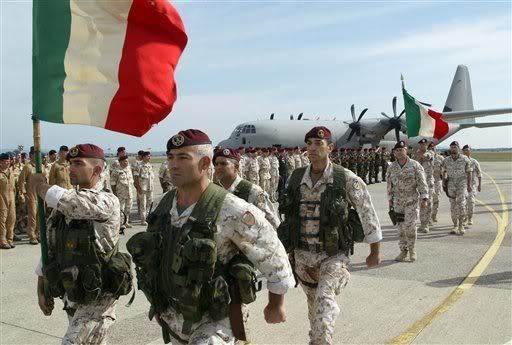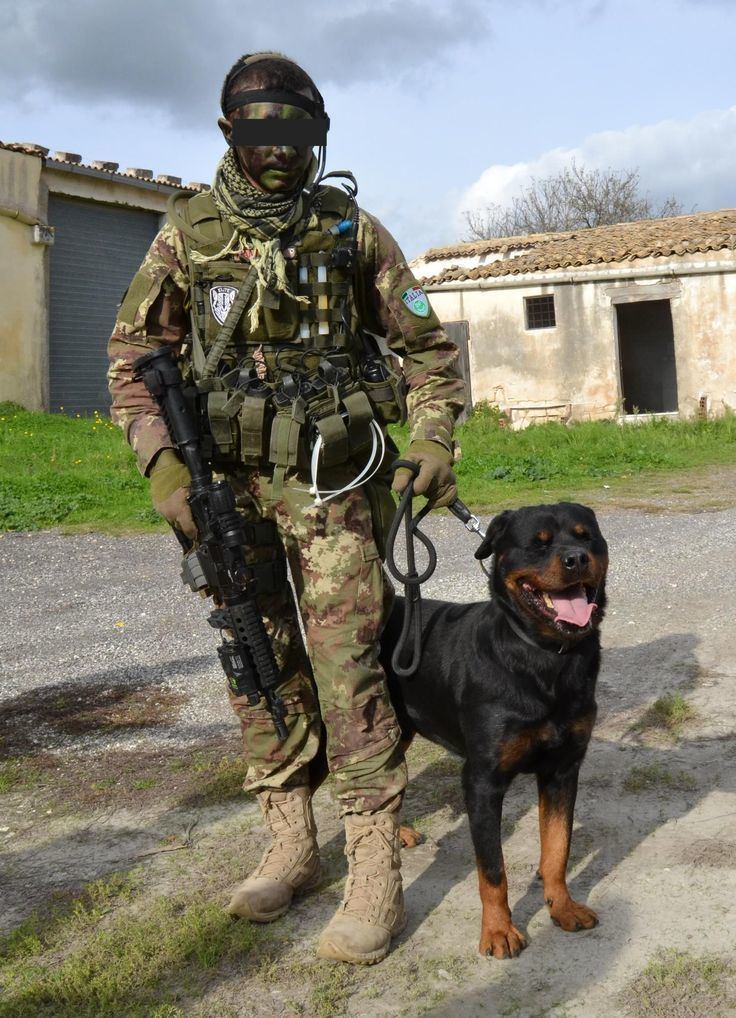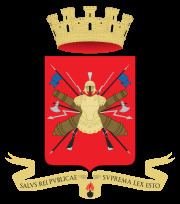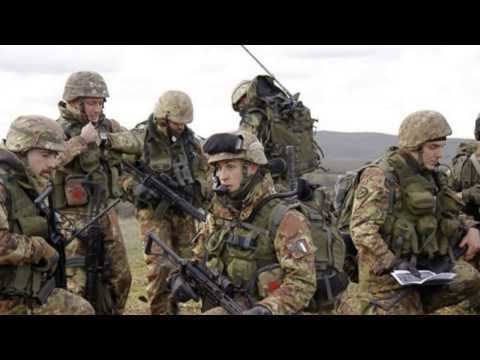Active 27 March 1861 – today Size 99,042 (2016) | Country Italy Founded 27 March 1861 | |
 | ||
Part of Italian Supreme Defense Council Similar Profiles | ||
The Italian Army (Italian: Esercito Italiano; EI) is the land defence force of the Italian Armed Forces of the Italian Republic. The army's history dates back to the unification of Italy in the 1850s and 1860s. The army fought in colonial engagements in China, Libya (1911–1912), northern Italy against the Austro-Hungarian Empire during World War I, Abyssinia before World War II, and in World War II in Albania, Greece, north Africa, Russia and Italy itself. During the Cold War the army prepared itself to defend against a Warsaw Pact invasion from the east. Since the end of the Cold War the army has seen extensive peacekeeping service and combat in Afghanistan and Iraq.
Contents
- History
- World War I
- World War II
- Cold War
- Post Cold War
- Unit Summary
- 1991 reform
- 1997 reform
- 2002 reform
- 2011 reform
- 2013 reform
- Operations
- Command structure
- Operational forces
- Effective operational capability
- Defunct branches
- References

Its best-known combat vehicles are the Dardo infantry fighting vehicle, the Centauro tank destroyer and the Ariete tank, and among its aircraft the Mangusta attack helicopter, recently deployed in UN missions.
The headquarters of the Army General Staff are located in Rome, at the back of the Presidential Palace. The army is an all-volunteer force of active-duty personnel, numbering 99,042 (2016) personnel in 2016.

History
The Italian Army originated as the Royal Army (Regio Esercito) which dates from the proclamation of the Kingdom of Italy following the seizure of the Papal States and the unification of Italy (Risorgimento). In 1861, under the leadership of Giuseppe Garibaldi, Victor Emmanuel II of the House of Savoy was invited to take the throne of the newly independent kingdom.

Italian expeditions were dispatched to China during the Boxer Rebellion of 1900 and to Libya during the Italo-Turkish War of 1911–1912.
World War I

The Italian Royal Army's first real taste of modern warfare was during World War I. Most of the actions were fought in northern Italy and the Royal Army suffered many casualties. This included over 700,000 dead. In particular, the frequency of the offensives in which Italian soldiers participated between May 1915 and August 1917, one every three months, was higher than demanded by the armies on the Western Front. Italian discipline was also harsher, with punishments for infractions of duty of a severity not known in the German, French, and British armies.
During the Interwar Years the Royal Army participated in the Italian Invasion of Ethiopia, provided men and materials during the Spanish Civil War to fight in the Corps of Volunteer Troops (Corpo Truppe Volontarie), and launched the Italian invasion of Albania.
World War II
On paper, the Royal Army was one of the largest ground forces in World War II, though in reality it could not field the numbers claimed, and it was one of the pioneers in the use of paratroopers. Due to their generally smaller size, many Italian divisions were reinforced by an Assault Group (Gruppo d'Assalto) of two battalions of Blackshirts (MVSN).
Reports of Italian military prowess in the Second World War were, almost always, dismissive. This perception was the result of disastrous Italian offensives against Egypt and the performance of the army in the Greco-Italian War. Both campaigns were ill-prepared and executed inadequately. The Italian 10th Army initially advanced into Egypt but surrendered after being pushed back into central Libya and almost all destroyed by a force one fifth its size in the British three-month campaign of Operation Compass.
Incompetent military leadership was aggravated by the Italian military's equipment, which predominantly dated back to the First World War and was not up to the standard of either the Allied or the German armies. Italian 'medium' M11, M13, M14 and M15 tanks were at a marked disadvantage against the comparatively heavily armed American Sherman tanks, for example. More crucially, Italy lacked suitable quantities of equipment of all kinds and the Italian high command did not take necessary steps to plan for possible setbacks on the battlefield, or for proper logistical support to its field armies. There were too few anti-aircraft weapons, obsolete anti-tank guns, and too few trucks.
The Italian Expeditionary Corps in Russia fought under General Giovanni Messe, who acknowledged the limitations of his Corps in material and equipment and thus was relieved of his command on November 1, 1942. When the Soviet offensive Operation Saturn began on December 12, 1942 the Italian 8th Army was quickly crushed. Only about a third of its troops managed to escape the Soviet cauldron, most notably from the three Alpini Divisions Tridentina, Julia and Cuneense, which fought stubbornly and to almost their total annihilation to escape the Soviet encirclement (see: Battle of Nikolayevka).
In North Africa, the Italian 132 Armored Division Ariete and the 185 Airborne Division Folgore fought to total annihilation at the Second Battle of El Alamein. Although the battle was lost, the determined resistance of the Italian soldiers at the Battle of Keren in East Africa is still commemorated today by the Italian military.
After the Axis defeat in Tunisia the morale of the Italian troops dropped and when the Allies landed in Sicily on July 10, 1943 most Italian Coastal divisions simply dissolved. The sagging morale led to the overthrow of Italian dictator Benito Mussolini by King Victor Emmanuel III of Italy 15 days later.
In September 1943, Italy made an armistice with the Allies and split into the Italian Social Republic – effectively a puppet state of Germany – in the north and that of the Badoglio government in the south. The Italian Co-Belligerent Army (Esercito Cobelligerante Italiano) was the army of the Italian royalist forces fighting on the side of the Allies in southern Italy after the Allied armistice with Italy in September 1943. The Italian soldiers fighting in this army no longer fought for Benito Mussolini as their allegiance was to King Victor Emmanuel and to Marshal of Italy (Maresciallo d'Italia) Pietro Badoglio, the men who ousted Mussolini.
Cold War
The kingdom was replaced by a Republic in 1946 and the Royal Army changed its name to become the Italian Army (Esercito Italiano). Initially five infantry divisions were active, including the newly renamed Infantry Division Friuli.
Following the creation of NATO, the Italian Army was integrated into NATO's Allied Forces Southern Europe and prepared for a feared invasion from the east, possibly via Yugoslavia. Allied Land Forces Southern Europe (LANDSOUTH), was activated on 10 July 1951 to defend northeastern Italy. The command was headquartered at Verona, and placed under Lieutenant General Maurizio Lazzaro De Castiglioni. Some three infantry divisions and three brigades were the only forces initially available to this command to defend northeastern Italy. The divisions in question were the Mantova Infantry Division in Udine, the Folgore Motorized Infantry Division in Treviso, the Trieste Motorized Infantry Division in Bologna. Two of the three brigades were Alpini mountain infantry brigades – the Julia Alpine Brigade in Cividale del Friuli and Tridentina Alpine Brigade in Brixen, while the third brigade was the Ariete Armoured Brigade in Pordenone. Exercise "Italic Weld", a combined air-naval-ground exercise in northern Italy involving the United States, Italy, Turkey, and Greece, appears to have been one of the first exercises in which the new Italian Army orientation was tested.
Later the Italian Army was divided into the III Army Corps (HQ Milan) (active from 1957), IV Alpine Army Corps (HQ Bolzano) (active from 1952), and V Army Corps (HQ Vittorio Veneto) (active from 1952), plus other units. The most significant reorganization of the Italian Army took place in 1975, when the regimental level was abolished and the battalions came under direct command of newly formed brigades. This reorganization came to an end in 1986 when the remaining four divisional headquarters were dissolved and all brigades in Northern Italy came under direct command of the Army's three Corps there, while the brigades in Central and Southern Italy came under operational control of the local administrative Military Regions.
Post Cold War
At the end of the Cold War in 1989 the Italian Army consisted of 26 Combat Brigades: four Armored Brigades, ten Mechanized Infantry Brigades, five Motorized Infantry Brigades, five Alpine Brigades, one Rocket Artillery Brigade and one Airborne Brigade.
The units were placed as follows under the three Army Corps's:
The brigades under operational control of the Military Regions were:
The Armored Brigades consisted of one Command & Signals Battalion, two or three Tank Battalions with Leopard 1A2 tanks, one Mechanized Infantry Battalion with M113 APCs, one Self-propelled Field Artillery Group with M109 howitzers, one Logistic Battalion, an Anti-Tank Company and an Engineer Company.
The Mechanized Brigades consisted of one Command & Signals Battalion, one Tank Battalion (Leopard 1), three Mechanized Infantry Battalions (M113), one Self-propelled Field Artillery Battalion with M109 howitzers, one Logistic Battalion, an Anti-Tank Company and an Engineer Company; however the Pinerolo Mechanized Brigades fielded a Field Artillery Group with FH-70 howitzers. Additionally the Gorizia and Mantova mechanized brigades fielded two Position Infantry battalions each, which were tasked with manning fortifications and bunkers along the Yugoslav-Italian border.
The Motorized Brigades consisted of one Command & Signals Battalion, one Armored Battalion (a mixed unit of tanks and mechanized infantry), three Motorized Infantry Battalions, one Field Artillery Group (FH-70), one Logistic Battalion, an Anti-Tank Company and an Engineer Company; however the Sassari Brigade did not contain a field artillery battalion.
The Folgore Parachute Brigade did field one Command & Signals Battalion, one Parachute Assault Battalion (a Special Forces Unit), three Parachute Infantry Battalions, one Airborne Field Artillery Group with Mod 56 howitzers, one Logistic Battalion, one Army Aviation Helicopter Battalion and an Engineer Company.
Three of the five Alpine Brigades consisted of one Command & Signals Battalion, two Alpini Battalions, one Alpini Training Battalion, two Mountain Artillery Groups (Mod 56), one Logistic Battalion, an Anti-Tank Company and an Engineer Company; while the Tridentina brigade fielded an Alpini d'Arresto Battalion instead of the Alpini Training Battalion. The exception was the Julia Alpine Brigade which consisted of one Command & Signals Battalion, four Alpini Battalions, one Alpini d'Arresto Battalion, one Alpini Training Battalion, three Mountain Artillery Battalions, one Logistic Battalion, an Anti-Tank Company and an Engineer Company, making the Julia the largest brigade of the Italian Army. The d'Arresto Alpini and Infantry units were designated to hold specific fortified locations directly at the border to slow down an attacking enemy. They were not a maneuver element but attached for training and logistic purposes to brigades stationed closest to the border.
The Missile Brigade Aquileia fielded a mix of heavy artillery and missile units, both capable of firing tactical nuclear weapons. The main missile weapon of the brigade was the MGM-52 Lance missile.
Unit Summary
In total the Italian Army fielded at the end of the Cold War:
Additionally the Army fielded 23 Anti-tank companies, one in each combat brigade with the exception of the Folgore and Sassari brigades
1991 reform
In 1991 the Army began the post-Cold War draw-down of its forces with the disbandment of seven brigades and a large number of smaller units. The brigades disbanded in 1991 were the Aquileia, Brescia, Goito, Mameli, Orobica, Trieste and Vittorio Veneto. The units subordinated to these brigades were mostly disbanded, while the Garibaldi brigade command was transferred with one of its battalions to Campania.
1997 reform
With the relaxing military situation the Italian Army kept drawing down forces and disbanding smaller military units, which necessitated a major reorganization by 1997 to merge the remaining battalions into coherent units and to disband now superfluous brigade commands. Thus a further six brigades were disbanded during the latter half of 1996 and 1997: Acqui, Cadore, Cremona, Gorizia, Legnano and Mantova. In addition the remaining units were moved to new bases, changed composition, designation and tasks. The three Army Corps's were renamed and their functions expanded: the 3rd Army Corps became the Projection Forces Command (COMFOP) commanding the rapid reaction forces of the Army, the 4th Alpine Army Corps became the Alpine Troops Command (COMALP) focusing on peace-keeping operations and the 5th Army Corps became the 1st Defense Forces Command (COMFOD1) tasked with defending Northern Italy. On January 1, 1998 the 2nd Defense Forces Command (COMFOD2) was activated in Naples and tasked with defending South and Central Italy. During the Cold War the Italian Army units were to be commanded during war by NATO's LANDSOUTH Command in Verona, on October 1, 1997 out of elements of the aforementioned NATO Command the new Operational Terrestrial Forces Command (COMFOTER) was activated. The COMFOTER took command of all the combat, combat support, combat service support and CIS units of the Italian Army. Along with the COMFOTER in Verona a Support Command (COMSUP) was raised in Treviso, which gained operational control of all the remaining combat support, combat service support and CIS units of the Army. The COMSUP controlled three division sized formation (Army Aviation Command, Air-Defense Artillery Command, C4-IEW Command) and three brigade sized formations (Field Artillery Brigade, Engineer Brigade, Logistic Support Command).
Thus after the 1997 reform the structure of the Italian Army was as follows:
2002 reform
Between 1997 and 2002 the Army continued to tweak the new structure and with the abolition of obligatory military service a further two brigades (Centauro, Tridentina) were disbanded in 2002. On December 1, 2000 the COMFOP became the NATO Rapid Deployable Corps Italy (NRDC-IT) and passed its subordinate units to the COMFOD 1 (Friuli, Folgore) and COMFOD 2 (Garibaldi) commands. The Friuli Brigade changed composition and became an airmobile brigade with Army Aviation, Cavalry and Infantry units. The COMSUP had already been reorganized and streamlined in 2000.
After 2002 the structure of the Italian Army was as follows:
2011 reform
During 2011 some small changes regarding the support units of the Army were enacted. The COMSUP took command of the Armys schools and merged them where possible with the support brigades. Minor units were moved South and to the island to reduce the Army's footprint in the wealthier North of Italy. At the same time the designation of the Pinerolo brigade was changed back to Mechanized Infantry Brigade. Afterwards the COMSUP consisted, besides four Army schools of the following commands:
2013 reform
In 2013 the Army began a major reform. The three corps level commands COMFOD 1, COMFOD 2 and COMALP were disbanded and the Mantova Division Command moved from Vittorio Veneto to Florence, where it was renamed as Division "Friuli", taking the name and traditions of the Friuli Air Assault Brigade. Together with the other two divisions Acqui and Tridentina it took command of the operational brigades of the Italian Army.
The Logistic Projection Command was disbanded and its units transferred to the brigades. As part of the reform the Army created the new Army Special Forces Command (COMFOSE) in Pisa, which took command of all Special Operations Forces of the Army. Furthermore the Operational Terrestrial Forces Command (COMFOTER) in Verona was split on 1 October 2016 into the COMFOTER - Army Operational Command in Rome and the COMFOTER - SUPPORT Command in Verona.
At the end of the reform in 2018 the plan envisions that the Army will consist of:
However as of February 2017 the merger of the Airmobile Brigade Friuli and the Cavalry Brigade Pozzuolo del Friuli, as well as the disbanding of the Granatieri di Sardegna Brigade, are on hold.
Each maneuver brigade, with the exception of the Pozzuolo del Friuli and Sassari brigades, will field the following units after the reform: one combat service support battalion with the brigade staff, one cavalry reconnaissance regiment, three combat maneuver regiments, one artillery regiment, one engineer regiment, one logistic regiment.
The Pozzuolo del Friuli brigade will field a cavalry reconnaissance regiment, an air-assault infantry regiment, an amphibious-assault infantry regiment, an army aviation reconnaissance helicopter regiment, an attack helicopter regiment, a field artillery regiment, an engineer regiment, a logistic regiment as well as the standard combat service support battalion with the brigade staff.
The Sassari brigade will not field a cavalry reconnaissance regiment and an artillery regiment, unless funds can be found to raise these units on the island of Sardinia.
All army schools, training regiments and training centres will be combined into the newly raised Army Formation, Specialisation and Doctrine Command (Comando per la Formazione, Specializzazione e Dottrina e dell’Esercito or COMFORDOT) in Rome.
Operations
The Italian Army has participated in operations to aid populations hit by natural disasters. It has, moreover, supplied a remarkable contribution to the forces of police for the control of the territory of the province of Bolzano/Bozen (1967), in Sardinia ("Forza Paris" 1992), in Sicily ("Vespri Siciliani"1992) and in Calabria (1994). Currently, it protects sensitive objects and places throughout the national territory ("Operazione Domino") since the September 11 attacks in the United States. The army is also engaged in Missions abroad under the aegis of the UN, the NATO, and of Multinational forces, such as Beirut in Lebanon (1982), Namibia (1989), Albania (1991), Kurdistan (1991), Somalia (1992), Mozambique (1993), Bosnia (1995), East Timor and Kosovo (both in 1999), the Democratic Republic of the Congo (2001), Darfur (2003), Afghanistan (2002), Iraq (2003) and Lebanon again (2006) (in fact during the period between 1980 and 2009, Italy was the third major world contributor, after USA and UK, in peacekeeping missions).
The Carabinieri, once the senior corps of the Army, is now an autonomous armed force (alongside the Army, Navy and Air Force). The Carabinieri provide military police services to all the Italian armed force.
Command structure
The Armed Forces of Italy are under the command of the Italian Supreme Defense Council, presided over by the President of the Italian Republic.
Operational forces
For the detailed structure of the Italian Army see Structure of the Italian Army.
Effective operational capability
All brigades may be deployed outside Italy and are often involved in peace-keeping operations on foreign soil. The brigades are combat brigades, numbering between 3–5,000 troops each. Units are designated as regiments, but field men and equipment comparable to large battalions and consist of a large Command, Logistics, and Support Company plus a combat battalion, which, in the case of light infantry units (Alpini, Lagunari and 66th Air-mobile Infantry Regiment Trieste), consists of:
In the mechanized infantry units (including Bersaglieri and Granatieri) the mortar and anti-tank companies are merged into a "Manoeuver Support Company", while the paracadutisti regiments field a "Maneuver and Paracadutisti Special Forces Operations Support Company".
Operations
A post-World War II peace treaty signed by Italy prevented the country from deploying military forces in overseas operations as well as possessing fixed-wing vessel-based aircraft for twenty-five years following the end of the war.
This treaty expired in 1970, but it would not be until 1982 that Italy first deployed troops on foreign soil, with a peacekeeping contingent being dispatched to Beirut following a United Nations request for troops. Since the 1980s, Italian troops have participated with other Western countries in peacekeeping operations across the world, especially in Africa, Balkan Peninsula and the Middle East.
As yet, the Italian Army has not engaged in major combat operations since World War II; though Italian Special Forces have taken part in anti-Taliban operations in Afghanistan as part of Task Force 'Nibbio'. Italy was not yet a member of the United Nations in 1950, when that organization went to war with North Korea.
Italy did take part in the 1990–91 Gulf War but solely through the deployment of eight Italian Air Force Panavia Tornado IDS bomber jets to Saudi Arabia; Italian Army troops were subsequently deployed to assist Kurdish refugees in northern Iraq following the conflict.
As part of Operation Enduring Freedom in response to the September 11, 2001 attacks, Italy contributed to the international operation in Afghanistan. Italian forces have contributed to ISAF, the NATO force in Afghanistan, and a Provincial reconstruction team and 53 Italian soldiers have died under ISAF. Italy has sent 4200 troops, based on one infantry company from the 2nd Alpini Regiment tasked to protect the ISAF HQ, one engineer company, one NBC platoon, one logistic unit, as well as liaison and staff elements integrated into the operation chain of command. Italian forces also command a multinational engineer task force and have deployed a platoon of Italian military police. Actually, Italy leads the Regional Command West in Afghanistan, and its HQ is located in Herat in the base of Camp Arena. Italian Air Force deployed about 30 aircraft among helicopters and planes; some of them are: four AMX Ghibli and two RQ-1A Predator that are used in close air support and intelligence missions, Alenia C-27J Spartan, Boeing CH-47C Chinook, NH90 and Lockheed C-130 Hercules, which are used in transport missions; UH-1N Twin Huey and Agusta A129CBT Mangusta are used in missions of fire support to the troops .
The Italian Army did not take part in combat operations of the 2003 Second Gulf War, dispatching troops only after May 1, 2003 – when major combat operations were declared over by the U.S. President George W. Bush. Subsequently Italian troops arrived in the late summer of 2003, and began patrolling Nasiriyah and the surrounding area. On 26 May 2006, Italian foreign minister Massimo d'Alema announced that the Italian forces would be reduced to 1,600 by June. As of June 2006 32 Italian troops have been killed in Iraq – with the greatest single loss of life coming on November 12, 2003 – a suicide car bombing of the Italian Carabinieri Corps HQ left a dozen Carabinieri, five Army soldiers, two Italian and eight Iraqi civilians dead.
As of 2006, Italy ranks third in the world in number of military forces operating in peacekeeping and peace-enforcing scenarios Afghanistan, Kosovo, Bosnia and Herzegovina, and Lebanon following only the United States and United Kingdom.
A recent law promotes membership of the Italian Army giving volunteers a chance to find post-Army careers in the Carabinieri, Italian State Police, Italian Finance Police, State Forestry Department, Fire Department and other state bodies.
